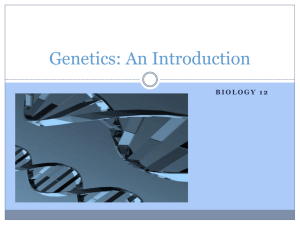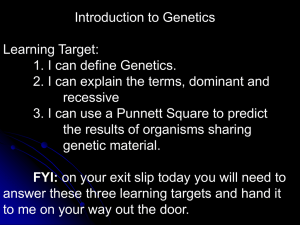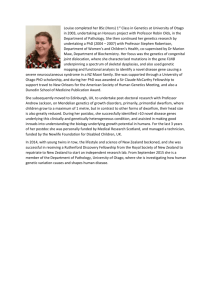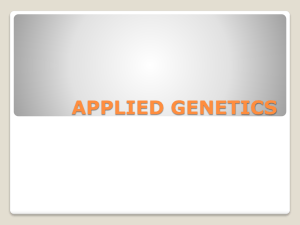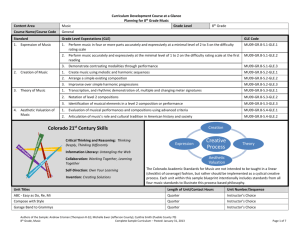Genetics and the Human Influence on Genes
advertisement
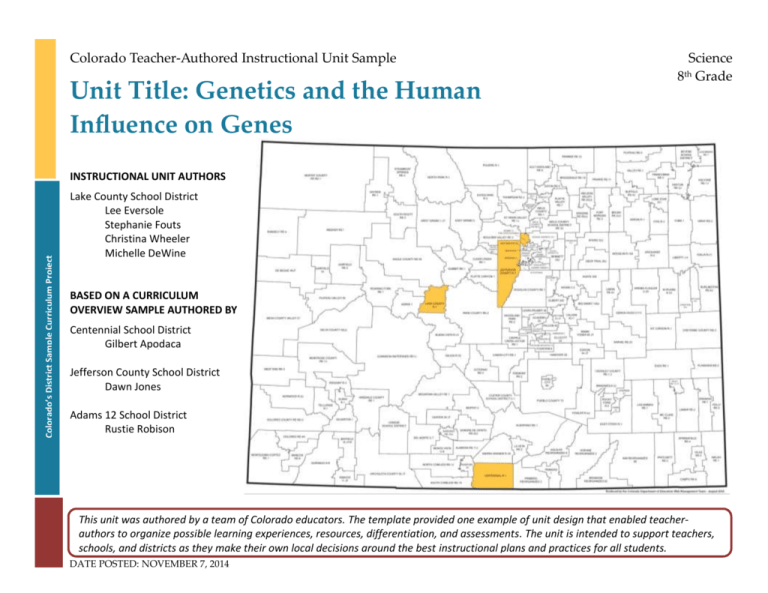
Colorado Teacher-Authored Instructional Unit Sample Science 8 Grade th Unit Title: Genetics and the Human Influence on Genes Colorado’s District Sample Curriculum Project INSTRUCTIONAL UNIT AUTHORS Lake County School District Lee Eversole Stephanie Fouts Christina Wheeler Michelle DeWine BASED ON A CURRICULUM OVERVIEW SAMPLE AUTHORED BY Centennial School District Gilbert Apodaca Jefferson County School District Dawn Jones Adams 12 School District Rustie Robison This unit was authored by a team of Colorado educators. The template provided one example of unit design that enabled teacherauthors to organize possible learning experiences, resources, differentiation, and assessments. The unit is intended to support teachers, schools, and districts as they make their own local decisions around the best instructional plans and practices for all students. DATE POSTED: NOVEMBER 7, 2014 Colorado Teacher-Authored Sample Instructional Unit Content Area Science Grade Level 8th Grade Course Name/Course Code Standard Grade Level Expectations (GLE) GLE Code 1. 1. Identify and calculate the direction and magnitude of forces that act on an object, and explain the results in the object’s change of motion SC09-GR.8-S.1-GLE.1 2. There are different forms of energy, and those forms of energy can be changed from one form to another – but total energy is conserved SC09-GR.8-S.1-GLE.2 3. Distinguish between physical and chemical changes, noting that mass is conserved during any change SC09-GR.8-S.1-GLE.3 4. Recognize that waves such as electromagnetic, sound, seismic, and water have common characteristics and unique properties SC09-GR.8-S.1-GLE.4 1. Human activities can deliberately or inadvertently alter ecosystems and their resiliency SC09-GR.8-S.2-GLE.1 2. Organisms reproduce and transmit genetic information (genes) to offspring, which influences individuals’ traits in the next generation SC09-GR.8-S.2-GLE.2 1. Weather is a result of complex interactions of Earth's atmosphere, land and water, that are driven by energy from the sun, and can be predicted and described through complex models SC09-GR.8-S.3-GLE.1 2. Earth has a variety of climates defined by average temperature, precipitation, humidity, air pressure, and wind that have changed over time in a particular location SC09-GR.8-S.3-GLE.2 3. The solar system is comprised of various objects that orbit the Sun and are classified based on their characteristics SC09-GR.8-S.3-GLE.3 4. The relative positions and motions of Earth, Moon, and Sun can be used to explain observable effects such as seasons, eclipses, and Moon phases SC09-GR.8-S.3-GLE.4 2. 3. Physical Science Life Science Earth Systems Science Reading & Writing Standards for Literacy in Science and Technical Subjects 6 - 12 Colorado 21st Century Skills Critical Thinking and Reasoning: Thinking Deeply, Thinking Differently Invention Information Literacy: Untangling the Web Collaboration: Working Together, Learning Together Self-Direction: Own Your Learning Invention: Creating Solutions Reading Standards Key Ideas & Details Craft And Structure Integration of Knowledge and Ideas Range of Reading and Levels of Text Complexity Writing Standards Text Types & Purposes Production and Distribution of Writing Research to Construct and Present Knowledge Range of Writing Unit Titles Length of Unit/Contact Hours Unit Number/Sequence Genetics and the Human Influence on Genes 7-9 weeks 4 8th Grade, Science Unit Title: Genetics and the Human Influence on Genes Page 1 of 18 Colorado Teacher-Authored Sample Instructional Unit Unit Title Genetics and the Human Influence on Genes Focusing Lens(es) Interactions Inquiry Questions (EngagingDebatable): Unit Strands Life Science, RWL – Oral Expression and Listening, RWL – Reading for All Purposes; RWL – Writing and Composition, RWL – Research and Reasoning, Math – Data Analysis, Statistics, and Probability Concepts Variation, Heredity, Interaction, Evolution, System, Population, Organism, Genetics Standards and Grade Level Expectations Addressed in this Unit Length of Unit 7-9 weeks SC09-GR.8-S.2-GLE.1 SC09-GR.8-S.2-GLE.2 How will genetic engineering be used when humans reach outer space? (SC09-GR.8-S.2-GLE.1,2-EO.a,b,c,d,e) Is genetic variation a positive or negative societal trait? Would discrimination occur if ALL genotypes were expressed as phenotypes? Do the benefits outweigh the risks of genetic technology (cloning, gene therapy, and genetically modified foods)? (SC09-GR.8-S.2-GLE.2; IQ.3) Generalizations My students will Understand that… Guiding Questions Factual Conceptual Organisms interact to reproduce and transmit genetic information to offspring, which is then, in turn, passed to future offspring. (SC09-GR.8-S.2-GLE.1-EO.a,b,c,d,e) How are traits passed from one generation to the next? (SC09-GR.8-S2-GLE.2; IQ.1) What is the difference between genotype and phenotype? (SC09-GR.8-S2-GLE.2-EO.d,e) How do organisms evolve over time? How can certain traits be passed to offspring, while others are not? (SC09-GR.8-S.2-GLE.2-EO.c,d; IQ.1,2) An organism’s variation reflects heredity due to the nature of genetics. (SC09-GR.8-S.2-GLE.2-EO.a,b,c,d,e) How does heredity influence an offspring’s variation? (SC09-GR.8-S.2-GLE.2-EO.a,b; IQ.2) What is a Punnett Square? How do you use one? (SC09GR.8-S.2-GLE.2-EO.c,d; IQ.2,3; N.1) How can patterns in the inheritance of traits be used to predict the frequency of traits appearing in offspring? (SC09-GR.8-GLE.2; IQ.3) Human technology and activities can alter systems of heredity and interaction which could impact society for future generations. (SC09-GR.8-S.2-GLE.1-EO.a,b) and (SC09-GR.8-S.2-GLE.2-EO.a,b; RA.1,2) What is the human role in genetic heredity of food items (plants and animal food)? (SC09-GR.8-S.2GLE.2; RA.1; N.2) What applications do genetic modifications have in agriculture and medicine? (SC09-GR.8-S.2-GLE.2; RA.1,2; N.2) 8th Grade, Science Unit Title: Genetics and the Human Influence on Genes Page 2 of 18 Colorado Teacher-Authored Sample Instructional Unit Critical Content: Key Skills: My students will Know… My students will be able to (Do)… How the ideas and beliefs about genetics have developed over time as new technologies and applications have been developed. (SC09-GR.8-S.2-GLE.2EO.a,b,c; RA.1; N.2) The role of environment in the expression of genes. (SC09-GR.8-S.2-GLE.2-EO.c,d,e; N.1,3) The classification of genotype and phenotype based on parent genotype and phenotype (including sex-linked traits, pedigrees, co-dominance, and karyotype). (SC09-GR.8-S.2-GLE.2-EO.d,e) The definition and uses of a Punnett Square. (SC09-GR.8-S.2-GLE.2-EO.d,e) Critically evaluate the benefits and risks of the technology associated with genetics. (SC09-GR.8-S.2-GLE.2-EO.a,b,c; RA.1; N.2) Evaluate various models of DNA inheritance and genes based strengths and weaknesses (SC09-GR.8-S.2-GLE.2-EO.c,d,e; N.1,3) Develop, communicate, and justify an evidence based scientific explanation for passing genetic information from one generation to the next. (SC09-GR.8-S.2GLE.2-EO.a,b,c; N.1,2) Use models, diagrams, and computer simulations to predict offspring phenotypes and genotypes based on parent genotypes. (SC09-GR.8-S.2-GLE.2-EO.d,e) Critical Language: includes the Academic and Technical vocabulary, semantics, and discourse which are particular to and necessary for accessing a given discipline. EXAMPLE: A student in Language Arts can demonstrate the ability to apply and comprehend critical language through the following statement: “Mark Twain exposes the hypocrisy of slavery through the use of satire.” A student in ______________ can demonstrate the ability to apply and comprehend critical language through the following statement(s): Traits of individuals are influenced by genes and/or environment (SC09-GR.8-S.2-GLE.2) Academic Vocabulary: simulation, analyze, interpret, evidence (direct and indirect), scientific investigation, distinguishing characteristics, models, critique, evaluate, compare and contrast Technical Vocabulary: traits, biotechnology, heredity, RNA (ribonucleic acid), DNA (deoxyribonucleic acid), phenotype, genotype, Punnett square, dominant, recessive, genetic technology, gene 8th Grade, Science Unit Title: Genetics and the Human Influence on Genes Page 3 of 18 Colorado Teacher-Authored Sample Instructional Unit Unit Description: This unit is focused on genetics and the transmission of traits. Beginning with using Punnett squares and pedigrees to predict possible offspring, the unit has students investigate Mendelian genetics, genetic engineering and modification, and the transmission and mutation of traits during reproduction. The unit culminates in a performance assessment that asks students to write an opinion/position paper for a local newspaper on one topic (GMOs, cloning, genetic counseling, etc.). Considerations: Teachers need to consider that some of the topics within this unit could be controversial and should proceed as the district requires. Unit Generalizations Key Generalization: Human technology and activities can alter systems of heredity and interaction which could impact society for future generations Supporting Generalizations: Organisms interact to reproduce and transmit genetic information to offspring, which is then, in turn, passed to future offspring An organism’s variation reflects heredity due to the nature of genetics Performance Assessment: The capstone/summative assessment for this unit. Claims: Human technology and activities can alter systems of heredity and interaction which could impact society for future generations. (Key generalization(s) to be mastered and demonstrated through the capstone assessment.) Stimulus Material: (Engaging scenario that includes role, audience, goal/outcome and explicitly connects the key generalization) You are preparing an opinion piece for a local newspaper on one topic related to genetics and community welfare (e.g., GMOs, cloning, genetic screening) to share with the general public. You could for example be a geneticist, a parent, a farmer, etc. You must research case studies on your topic and utilize scientific findings to assist you in defending your position (include a minimum of three sources). You must also use relevant background genetic information pertaining to your specific topic. http://writetodone.com/how-to-write-a-strong-opinion-piece-for-your-blog/ (Steps for how to write a strong opinion piece) Product/Evidence: Students must write a persuasive essay/position paper on one topic (GMOs, cloning, genetic counseling, etc.). They must have researched case studies on their topic and included at least three reputable sources. Students also must include relevant genetic information pertaining to their topic (e.g., mutations, genetic variation, probability, pedigrees). (Expected product from students) Differentiation: (Multiple modes for student expression) The teacher may provide some sources for the students on the topics suggested. The teacher may provide a template for writing the opinion paper. The teacher may provide a checklist. The teacher may allow students to select a perspective such as a geneticist, a parent, a doctor, a farmer, etc. To extend this work, students may prepare a script for a 10minute “TED talk” to share with general public. Texts for independent reading or for class read aloud to support the content Informational/Non-Fiction Genetic Engineering - M. Cohen [Lexile level 840] Traits and Attributes - N. Hyde [Lexile level 860] 8th Grade, Science Fiction The Dog Who Wouldn’t Be - F. Mowat [Lexile level 1280] Unit Title: Genetics and the Human Influence on Genes Page 4 of 18 Colorado Teacher-Authored Sample Instructional Unit Ongoing Discipline-Specific Learning Experiences 1. Description: Skills: Communicating like a scientist: viewing and synthesize multiple perspectives Comprehension of academic vocabulary Extracting main ideas Making predictions Identifying key points and themes Identify faults in research methods, logic, and statistical findings Scrutinize credibility of sources Teacher Resources: http://science-curriculum.lakecountyhs.schoolfusion.us/modules/locker/files/group_files.phtml?parent=24482304&gid=440206 3&sessionid=c1305047b374753db7924f5a8ebb7b18 (Multi-pass Reading Strategy for Case Studies) Student Resources: http://science-curriculum.lakecountyhs.schoolfusion.us/modules/locker/files/group_files.phtml?parent=24482304&gid=440206 3&sessionid=c1305047b374753db7924f5a8ebb7b18 (Lab Template) Assessment: Students will prepare lab write-ups for various experiences. http://science-curriculum.lakecountyhs.schoolfusion.us/modules/locker/files/group_files.phtml?parent=24482304&gid=440206 3&sessionid=c1305047b374753db7924f5a8ebb7b18 (Lab Write-Up Rubrics) Prior Knowledge and Experiences Students must have a basic understanding of cell structure and function, reproduction, DNA, percentages, ratio, and fractions. Vertical alignment of life science: Students have last seen concepts related to this unit in 5th, 4th, 3rd, and 1st grades. Learning Experiences # 1 – 4 Instructional Timeframe: Weeks 1-2 Learning Experience # 1 The teacher may use simulations/media about the meiotic process so that students can begin modeling (e.g., using pipe cleaners, string) the principles of sex determination. Generalization Connection(s): An organism’s variation reflects heredity due to the nature of genetics Organisms interact to reproduce and transmit genetic information to offspring, which is then, in turn, passed to future offspring Teacher Resources: http://serendip.brynmawr.edu/sci_edu/waldron/pdf/MitosisMeiosisProtocol.pdf (Information sheet on Mitosis, Meiosis, and Fertilization) http://www.biologycorner.com/worksheets/meiosis2.html (Worksheet on meiosis) http://naturalsciences.sdsu.edu/classes/lab2.5/lab2.5.html#anchor29709092 (Modeling meiosis lab) 8th Grade, Science Unit Title: Genetics and the Human Influence on Genes Page 5 of 18 Colorado Teacher-Authored Sample Instructional Unit Student Resources: http://www.cellsalive.com (Interactive site where students can look inside cells) http://www.sumanasinc.com/webcontent/animations/content/meiosis.html (Meiosis animation) http://www.phschool.com/science/biology_place/labbench/lab3/intro.html (Mitosis and meiosis lab) Assessment: Students will create a model of the process and products of meiosis. http://www.youtube.com/watch?v=XpZxNCVjPpE (You tube video of meiosis model using clay) http://www.rcsnc.org/UserFiles/Servers/Server_4702937/File/lynne%20huskey/Modeling%20Meiosis.doc (Meiosis modeling writeup) Differentiation: (Multiple means for students to access content and multiple modes for student to express understanding.) Access (Resources and/or Process) Extensions for depth and complexity: Access (Resources and/or Process) The teacher may provide a meiosis chart to allow the students to follow along visually The teacher may allow students to work with peers to complete the lab The teacher may ask the student to compare and contrast mitosis with meiosis The student may verbally demonstrate their understanding of meiosis one-on-one with the teacher The student may create a model for comparing mitosis and meiosis Critical Content: Key Skills: Model the process of meiosis Critical Language: DNA, Centriole, Nucleus, Nuclear membrane, Meiosis, Sex cell, Gamete, Prophase, Metaphase, Anaphase, Telophase, Chromosome, Zygote, Daughter cells, Sequencing, Model 8th Grade, Science DNA Centriole Nucleus Nuclear membrane Meiosis Sex cell Gamete Prophase Metaphase Anaphase Telophase Chromosome Zygote Daughter cells Unit Title: Genetics and the Human Influence on Genes Page 6 of 18 Colorado Teacher-Authored Sample Instructional Unit Learning Experience # 2 The teacher may introduce the concepts of genotype and phenotype so that students can recognize the various forms of their representation (i.e., as variables and as written forms-descriptive words). Generalization Connection(s): An organism’s variation reflects heredity due to the nature of genetics Organisms interact to reproduce and transmit genetic information to offspring, which is then, in turn, passed to future offspring Teacher Resources: http://sciencespot.net/Media/gen_smilewkst1.pdf (Activity with alleles) https://docs.google.com/file/d/0Bz9eBjqfJlfDX3VVb2FzeG5JUVE/edit?pli=1 (Genotype and Phenotype lab) Student Resources: https://www.kaskaskia.edu/BCambron/Biology%20101/Writing%20Phenotypes%20and%20Genotypes.htm (How to write genotypes and phenotypes) http://examples.yourdictionary.com/examples-of-genotype-phenotype.html (Genotype and phenotypes examples) Assessment: Students will complete a set of example statements to determine whether a statement is describing a phenotype or genotype. Differentiation: (Multiple means for students to access content and multiple modes for student to express understanding.) Access (Resources and/or Process) Expression (Products and/or Performance) The teacher may provide a cloze model to assist students in their determinations http://worksheets.theteacherscorner.net/make-your-own/fillin-the-blank/ (The teacher corner cloze worksheet creator) The student may work one-on-one with a teacher and point to (or verbally describe) the correct answers Extensions for depth and complexity: Access (Resources and/or Process) Expression (Products and/or Performance) The teacher may provide opportunities for students to create their own examples The student creates their own examples of phenotypes and genotypes based on what has been determined to be dominant and recessive traits Critical Content: Key Skills: Differentiating between genotype and phenotype Comparing/contrasting various traits Determining dominant versus recessive traits Critical Language: Alleles, Gene, Recessive, Dominant, Genotype, Phenotype, Homozygous, Heterozygous, Gene expression, Differentiating, Comparing/Contrasting, Determining 8th Grade, Science Alleles Gene Recessive Dominant Genotype Phenotype Homozygous Heterozygous Gene expression Unit Title: Genetics and the Human Influence on Genes Page 7 of 18 Colorado Teacher-Authored Sample Instructional Unit Learning Experience # 3 The teacher may discuss differences between dominant and recessive alleles so that students can evaluate and differentiate various phenotypes and genotypes in order to make determinations about dominant and recessive traits. Generalization Connection(s): An organism’s variation reflects heredity due to the nature of genetics Organisms interact to reproduce and transmit genetic information to offspring, which is then, in turn, passed to future offspring Teacher Resources: http://sciencespot.net/Media/gen_smilewkst1.pdf (Activity with alleles) https://docs.google.com/file/d/0Bz9eBjqfJlfDX3VVb2FzeG5JUVE/edit?pli=1 (Genotype and Phenotype lab) Student Resources: https://www.kaskaskia.edu/BCambron/Biology%20101/Writing%20Phenotypes%20and%20Genotypes.htm (How to write genotypes and phenotypes) http://examples.yourdictionary.com/examples-of-genotype-phenotype.html (Genotype and phenotypes examples) Assessment: Students will research up to 10 traits to determine which are dominant and recessive and provide the corresponding genotype and phenotype for those traits. Differentiation: (Multiple means for students to access content and multiple modes for student to express understanding.) Access (Resources and/or Process) Expression (Products and/or Performance) The teacher may provide a cloze model to assist students in their determinations http://worksheets.theteacherscorner.net/make-your-own/fillin-the-blank/ (The teacher corner cloze worksheet creator) The student may work one-on-one with a teacher and point to the correct answers Extensions for depth and complexity: Access (Resources and/or Process) Expression (Products and/or Performance) The teacher may provide opportunities for students to research more obscure traits to determine which are dominant versus recessive The student may share results of what has been determined to be dominant and recessive traits Critical Content: Key Skills: Differentiating between genotype and phenotype Comparing/contrasting various traits Determining dominant versus recessive traits Critical Language: Alleles, Gene, Recessive, Dominant, Genotype, Phenotype, Homozygous, Heterozygous, Gene expression, Differentiating, Comparing/Contrasting, Determining 8th Grade, Science Alleles Gene Recessive Dominant Genotype Phenotype Homozygous Heterozygous Gene expression Unit Title: Genetics and the Human Influence on Genes Page 8 of 18 Colorado Teacher-Authored Sample Instructional Unit Learning Experience # 4 The teacher may lead an investigation on probability (e.g., using coin-flips, die throws) so that students can begin to consider the connections between probabilities and inherited traits. Generalization Connection(s): An organism’s variation reflects heredity due to the nature of genetics Organisms interact to reproduce and transmit genetic information to offspring, which is then, in turn, passed to future offspring Teacher Resources: http://www.mathworksheets4kids.com/probability.html (Probability worksheets) http://www.nsa.gov/academia/_files/collected_learning/middle_school/algebra/mysteries_chance.pdf (Decoding the mysteries of chance) http://mypages.iit.edu/~smile/bi8602.html (Beans and Genes probability activity) Student Resources: http://www.mathsisfun.com/data/probability.html (Different representations of probability) https://www.youtube.com/watch?v=Sqq4k50dxbI (You tube video on probability) Assessment: Students complete a data table and a graph documenting probability outcomes from the lab. http://www.mathsisfun.com/data/ (Math is fun probability tables and graphs) https://www.google.com/search?q=probability+data+table+and+graphs&biw=1366&bih=648&tbm=isch&tbo=u&source=univ&sa=X &ei=-HlSVKSHN5TooASD34HwBA&ved=0CCsQsAQ (Images of probability tables and graphs) Differentiation: (Multiple means for students to access content and multiple modes for student to express understanding.) Access (Resources and/or Process) Expression (Products and/or Performance) The teacher may provide math manipulatives to assist with fractions and percentages The student may partner with another student to complete data table and graph Extensions for depth and complexity: Access (Resources and/or Process) Expression (Products and/or Performance) The teacher may ask students to predict the outcome of the lab The student may make predictions about what the outcome of the lab will be prior to completing the lab Critical Content: Key Skills: Calculating probability Critical Language: Probability, Percentage, Fraction, Outcome, Calculating 8th Grade, Science Probability Percentage Fraction Outcome Unit Title: Genetics and the Human Influence on Genes Page 9 of 18 Colorado Teacher-Authored Sample Instructional Unit Learning Experiences # 5 – 7 Instructional Timeframe: Weeks 3-5 Learning Experience # 5 The teacher may utilize a statistical lab on alleles (e.g., Punnett Squares) so that students can experiment with predicting the probability of phenotypes, such as attached earlobes, widow’s peak, dimples, etc. Generalization Connection(s): An organism’s variation reflects heredity due to the nature of genetics Organisms interact to reproduce and transmit genetic information to offspring, which is then, in turn, passed to future offspring Teacher Resources: http://teach.genetics.utah.edu/content/heredity/docs/InventoryComplete.pdf (An inventory of my traits lab) http://www.cpet.ufl.edu/wp-content/uploads/2013/03/Genetics-with-a-smile-worksheet-and-activity-explores-heritability-oftraits.pdf (Working with alleles lab) http://it.pinellas.k12.fl.us/Teachers8/HolewinskiL/files/1BAFD4168BDB4C389C35C0F8FD41100F.pdf (Determining genotypes and phenotypes in humans lab) https://www.nlm.nih.gov/exhibition/harrypottersworld/pdf/teachersmonstergeneticslab.pdf (Monster genetics lab) http://www.biologyjunction.com/baby_lab.pdf (Create a baby by flipping coins for traits lab) http://www.nclark.net/gummybeargenetics.pdf (Gummy bear genetics) http://sciencespot.net/Media/gen_spbobgenetics2.pdf (Science Spot Sponge Bob genetics) http://www.sagepub.com/upm-data/39864_leppien_ch1.pdf (Sage publications chapter on genetics) Student Resources: http://www.exploringnature.org/db/detail.php?dbID=22&detID=2290 (Using punnett squares) http://learn.genetics.utah.edu/content/inheritance/ (Genetics Science Learning Center-Characteristics of Inheritance) http://www.zerobio.com/drag_gr11/mono.htm (Drag and drop genetics-interactive genotyping) http://www.athro.com/evo/gen/punexam.html (Interactive Punnett square quiz) http://www.youtube.com/watch?v=prkHKjfUmMs (You tube on how to create and use Punnett Squares) Assessment: Students will complete a Punnett square indicating the results of their allele combinations and draw a human face with the indicated (based on genotype) phenotypes. https://www.google.com/search?q=probability+data+table+and+graphs&biw=1366&bih=648&tbm=isch&tbo=u&source=univ&sa=X &ei=-HlSVKSHN5TooASD34HwBA&ved=0CCsQsAQ#tbm=isch&q=how+tro+complete+a+punnett+square (Images of Punnett Squares) http://www.youtube.com/watch?v=prkHKjfUmMs (You tube on how to create and use Punnett Squares) Differentiation: (Multiple means for students to access content and multiple modes for student to express understanding.) Access (Resources and/or Process) Expression (Products and/or Performance) The teacher may provide a Punnett square that is already labeled so that students only have to complete crosses The student may complete the partial Punnettt Square 8th Grade, Science Unit Title: Genetics and the Human Influence on Genes Page 10 of 18 Colorado Teacher-Authored Sample Instructional Unit Extensions for depth and complexity: Access (Resources and/or Process) Expression (Products and/or Performance) The teacher may allow the student to survey the class, collect data on the class’ facial phenotypes, and make predictions on genotype The teacher may provide more alleles for the students to use in the Punnett square (e.g., 8x8, 10x 10) The student may create a data table of phenotypes, listing predicted genotypes, and supporting their rationale for their predictions The student may complete more complex Punnett Squares involving multiple alleles at one time Critical Content: Key Skills: Analyzing allele combinations Critical Language: Phenotype, Allele, Genotype, Dominant, Recessive, Heterozygous, Homozygous, Gene expression, Analyzing allele combinations Phenotype Allele Genotype Dominant Recessive Heterozygous Homozygous Gene expression Learning Experience # 6 The teacher may introduce more complex ways to model gene expression (an expanded Punnett square and pedigree) so that students can explore sex-linked traits and make determinations on how they are inherited. Generalization Connection(s): An organism’s variation reflects heredity due to the nature of genetics Organisms interact to reproduce and transmit genetic information to offspring, which is then, in turn, passed to future offspring Teacher Resources: http://www.ck12.org/book/CK-12-Life-Science-Concepts-For-Middle-School/r22/section/3.14/ (Book excerpt) http://www.dnai.org/teacherguide/pdf/ts_romanovs.pdf (Teacher guide to genetics) http://www.pedigreequery.com/generator/ (Pedigree chart creator) Student Resources: http://education-portal.com/academy/lesson/exceptions-to-independent-assortment-sex-linked-and-sex-limited-traits.html#lesson (Lesson on sex-linked traits) https://www.khanacademy.org/science/biology/heredity-and-genetics/v/sex-linked-traits (Khan Academy genetics lesson) http://www.youtube.com/watch?v=Ir1t9awmUl4 (Understanding pedigrees movie) Assessment: Students will complete pedigrees based on case studies of families carrying sex-linked traits. https://www.google.com/search?q=pedigrees&es_sm=93&biw=1093&bih=534&tbm=isch&tbo=u&source=univ&sa=X&ei=XhlAVK6PIeoyAS724HYDg&ved=0CCYQsAQ (Images of pedigrees) http://www.pedigreequery.com/generator/ (Pedigree chart creator) 8th Grade, Science Unit Title: Genetics and the Human Influence on Genes Page 11 of 18 Differentiation: (Multiple means for students to access content and multiple modes for student to express understanding.) Extensions for depth and complexity: Colorado Teacher-Authored Sample Instructional Unit Access (Resources and/or Process) Expression (Products and/or Performance) The teacher may provide a cloze model of a Punnett square and pedigree The student may work one-on-one with teacher or aide to verbally describe the information for the pedigree Access (Resources and/or Process) Expression (Products and/or Performance) The teacher may provide a pedigree which contains more complex relationships and generations http://www.gettysburg.k12.pa.us/webpages/cbiggins/acceler ated_bio.cfm?subpage=1682011 (Notes page on sexlinked traits for ideas) The student may complete a more complex pedigree (e.g., multiple founding lineages, inbreeding, and half-sibling relationships https://www.google.com/search?q=complex+pedigrees&biw=1366 &bih=648&source=lnms&tbm=isch&sa=X&ei=vXtSVJrROdjpoASi ooDwBA&ved=0CAYQ_AUoAQ (Images for complex pedigrees) Critical Content: Key Skills: Calculating probability and ratios Employing deductive reasoning Providing inferences Critical Language: Sex-linked trait, Dominant, Recessive, Allele, Homozygous, Heterozygous, Gene, Gene expression, Punnett square, Pedigree, Probability, Ratio, Calculating probability and ratios, Deduction, Inference Sex-linked trait Dominant Recessive Allele Homozygous Heterozygous Gene Gene expression Punnett square Pedigree Probability Ratio Learning Experience # 7 The teacher may provide opportunities to explore the relationship among alleles where both alleles contribute to the phenotype of the heterozygote (co-dominance) so that students can investigate variations in the gene pool. Generalization Connection(s): An organism’s variation reflects heredity due to the nature of genetics Organisms interact to reproduce and transmit genetic information to offspring, which is then, in turn, passed to future offspring Teacher Resources: http://serendip.brynmawr.edu/exchange/waldron/dragongenetics2 (A simulation activity around inheritance) http://serendip.brynmawr.edu/sci_edu/waldron/#blood (Using blood test to identify babies) https://www.google.com/search?q=co-dominance&es_sm=93&biw=1093&bih=534&tbm=isch&tbo=u&source=univ&sa=X&ei=BtAVLOYNqfg8gGZj4HoBw&sqi=2&ved=0CCsQsAQ#tbm=isch&q=co-dominance+pedigrees (Images for co-dominant pedigrees) 8th Grade, Science Unit Title: Genetics and the Human Influence on Genes Page 12 of 18 Student Resources: Colorado Teacher-Authored Sample Instructional Unit https://www.nlm.nih.gov/exhibition/harrypottersworld/pdf/lesson2.pdf (Harry Potter genetics lesson) http://en.wikipedia.org/wiki/ABO_blood_group_system#mediaviewer/File:ABO_system_codominance.svg (Blood group lesson for co-dominance) http://www.hobart.k12.in.us/jkousen/Biology/inccodom.htm (Notes page on co-dominance and incomplete dominance) Assessment: Students will complete pedigrees based on case studies of families carrying co-dominant traits and provides written rationale for their pedigree choices. http://chroma.gs.washington.edu/outreach/genetics/sickle/sickle-back.html (Sickle Cell case study) https://www.google.com/search?q=co-dominance&es_sm=93&biw=1093&bih=534&tbm=isch&tbo=u&source=univ&sa=X&ei=BtAVLOYNqfg8gGZj4HoBw&sqi=2&ved=0CCsQsAQ#tbm=isch&q=co-dominance+pedigrees (Images for co-dominant pedigrees) Differentiation: (Multiple means for students to access content and multiple modes for student to express understanding.) Access (Resources and/or Process) Expression (Products and/or Performance) The teacher may provide a scaffold of the case study selected (e.g., cloze, word bank) The teacher may provide students with co-dominance information without having them read a case study The student may complete a pedigree for co-dominance and verbally explain their rationale Extensions for depth and complexity: Access (Resources and/or Process) Expression (Products and/or Performance) The teacher may provide opportunities for students to extend co-dominance (e.g., exploring incomplete dominance) The student may report out on the results between co-dominance and incomplete dominance (e.g., written report, Power Point presentation) Critical Content: Key Skills: Calculating probability Creating a pedigree Using deductive reasoning Critical Language: Co-dominance, Dominant, Recessive, Allele, Homozygous, Heterozygous, Gene, Gene expression, Punnett square, Pedigree, Probability, Ratio, Calculating probability and ratios, Deduction, Inference 8th Grade, Science Co-dominance Dominant Recessive Allele Homozygous Heterozygous Gene Gene expression Punnett square Pedigree Probability Unit Title: Genetics and the Human Influence on Genes Page 13 of 18 Colorado Teacher-Authored Sample Instructional Unit Learning Experiences # 8 - 11 Instructional Timeframe: Weeks 5 - 7 Learning Experience # 8 The teacher may create an investigation around mutations so that students can explore and explain how mutations can lead to the development of new traits. Generalization Connection(s): An organism’s variation reflects heredity due to the nature of genetics Organisms interact to reproduce and transmit genetic information to offspring, which is then, in turn, passed to future offspring Human technology and activities can alter systems of heredity and interaction which could impact society for future generations Teacher Resources: http://www.ndsu.edu/pubweb/~mcclean/plsc431/popgen/popgen4.htm (Evolutionary genetics) http://evolution.berkeley.edu/evolibrary/article/0_0_0/mutations_05 (Understanding mutations) http://ghr.nlm.nih.gov/handbook/mutationsanddisorders/genemutation (Handbook of mutations) Student Resources: http://kidshealth.org/teen/your_body/health_basics/genes_genetic_disorders.html# (Kids Health on genetic disorders) http://www.nhs.uk/Conditions/Genetics/Pages/Facts.aspx (Facts pages on genetics) http://dictionary.kids.net.au/word/mutation (Kids dictionary) Assessment: Students will create visual representations of traits before and after the mutations have occurred. http://www.bio.miami.edu/dana/dox/wildtype.html (Wild type versus mutation expressions) Differentiation: (Multiple means for students to access content and multiple modes for student to express understanding.) Access (Resources and/or Process) Expression (Products and/or Performance) The teacher may provide students with a graphic organizer to capture their thinking on mutations The teacher may allow students to work in pairs The student may complete a graphic organizer as their visual representation Extensions for depth and complexity: Access (Resources and/or Process) Expression (Products and/or Performance) The teacher may allow students to investigate why some mutations are more prevalent in some races, but not others http://discovermagazine.com/2013/julyaug/07-mostmutations-in-the-human-genome-are-recent-andprobably-harmful (Discover magazine article) The student may report their findings about mutations linked to race Critical Content: 8th Grade, Science The development of ideas and beliefs about genetics over time (with the advent of new technologies and applications) The role of environment in the expression of genes Development of GMOs and their pros and cons Mutations and the their influence on birth effects Natural mutations vs. technologically induced mutations Unit Title: Genetics and the Human Influence on Genes Page 14 of 18 Colorado Teacher-Authored Sample Instructional Unit Key Skills: Critically evaluate the benefits and risks of the technology associated with genetics Evaluate various models of DNA inheritance and genes based strengths and weaknesses Develop, communicate, and justify an evidence based scientific explanation for passing genetic information from one generation to the next Critical Language: Simulation, Analyze, Interpret, Evidence (direct and indirect), Scientific investigation, Distinguishing characteristics, Models, Compare and contrast, Traits, Biotechnology, Heredity, RNA (ribonucleic acid), DNA (deoxyribonucleic acid), Phenotype, Genotype, Genetic technology, Gene Learning Experience # 9 The teacher may introduce examples of genetic mutations so that students can delineate specific ways mutations can be beneficial and/or harmful. Teacher note: students can apply these examples to generational mutations in organisms such as aphids, bacteria, etc. Generalization Connection(s): Organisms interact to reproduce and transmit genetic information to offspring, which is then, in turn, passed to future offspring An organism’s variation reflects heredity due to the nature of genetics Human technology and activities can alter systems of heredity and interaction which could impact society for future generations Teacher Resources: http://www.genetics.edu.au/Publications-and-Resources/Genetics-Fact-Sheets/FactSheet5 (Genetic fact sheet) http://www.nhs.uk/Conditions/Genetics/Pages/Facts.aspx (Genetics fact sheet) Student Resources: http://genetics.thetech.org/about-genetics/mutations-and-disease (The museum of tech- mutations and disease) http://evolution.berkeley.edu/evolibrary/article/0_0_0/mutations_07 (Berkeley article on mutations) Assessment: Students will complete a short constructed response including graphs and models analyzing a case study and emphasizing the resulting genotype/phenotype from the mutations. http://evolution.berkeley.edu/evolibrary/article/mutations_06 (Case study on sickle cell anemia) Differentiation: (Multiple means for students to access content and multiple modes for student to express understanding.) Access (Resources and/or Process) Expression (Products and/or Performance) The teacher may provide students with a writing template The teacher may provide a shortened version of the case study The student may create a visual representation of their response to the case study www.prezi.com (Prezi presentation creator) Extensions for depth and complexity: Access (Resources and/or Process) Expression (Products and/or Performance) The teacher may allow students to research a case study of their choice of mutations in plants and specifically look for commonalities to human mutations The student may create a presentation to share their results/research with the class Critical Content: 8th Grade, Science The development of ideas and beliefs about genetics over time (with the advent of new technologies and applications) The role of environment in the expression of genes Genetic mutations of insects on alternating generations (development of wings) Unit Title: Genetics and the Human Influence on Genes Page 15 of 18 Colorado Teacher-Authored Sample Instructional Unit Key Skills: Critically evaluate the benefits and risks of the technology associated with genetics Evaluate various models of DNA inheritance and genes based strengths and weaknesses Develop, communicate, and justify an evidence based scientific explanation for passing genetic information from one generation to the next Use models, diagrams, and computer simulations to predict offspring phenotypes and genotypes based on parent genotypes Critical Language: Analyze, Interpret, Evidence (direct and indirect), Scientific investigation, Distinguishing characteristics, Models, Critique, Compare and contrast, Traits, Biotechnology, Heredity, RNA, DNA, Phenotype, Genetic technology, Gene Learning Experience # 10 The teacher may provide opportunities to explore multiple perspectives on human manipulation of genes (i.e., jigsaw, case studies on GMOs, cloning, genetic screening) so that students can develop insight on and synthesize various perspectives around intentional genetic mutation. Generalization Connection(s): Human technology and activities can alter systems of heredity and interaction which could impact society for future generations Teacher Resources: http://science.howstuffworks.com/life/genetic/designer-children.htm (How stuff works-genetics) http://www.forbes.com/sites/jonentine/2013/10/14/2000-reasons-why-gmos-are-safe-to-eat-and-environmentally-sustainable/ (Article on GMOs) http://www.nature.com/news/case-studies-a-hard-look-at-gm-crops-1.12907 (Case study on GMOs) http://www.globalchange.com/geneticengin.htm (Genetic engineering) http://www.nytimes.com/2013/07/28/science/a-race-to-save-the-orange-by-altering-its-dna.html?_r=0 (NY Times article on genetic engineering) http://www.geneticsandsociety.org/article.php?id=122 (article on genetic engineering) Student Resources: http://tiki.oneworld.org/genetics/GE6.html (Grade 6 genetics article) http://tiki.oneworld.org/genetics/GE7.html (Grade 7 genetics article) http://curiosity.discovery.com/question/how-does-genetic-engineering-work (Article on genetic engineering) http://swcoalition.org/2013/09/gmo-case-studies/ (Case study on GMO) http://www.abc.net.au/science/slab/consconf/studies.htm (case study genetics) Assessment: Students will write a summary of one of the case studies (or jigsaw) and provide their personal opinion about what they read. http://www.mwit.ac.th/~haiyang/english/week11/Opinion%20Piece%20Template.doc (Opinion piece template) http://writetodone.com/how-to-write-a-strong-opinion-piece-for-your-blog/ (Steps for how to write a strong opinion piece) Differentiation: (Multiple means for students to access content and multiple modes for student to express understanding.) Access (Resources and/or Process) Expression (Products and/or Performance) The teacher may provide readings that are in various Lexile ranges (e.g., Genetic Engineering - M. Cohen [lexile level 840], Traits and Attributes - N. Hyde [lexile level 860]) The student may dictate their opinion piece to a teacher 8th Grade, Science Unit Title: Genetics and the Human Influence on Genes Page 16 of 18 Colorado Teacher-Authored Sample Instructional Unit Extensions for depth and complexity: Access (Resources and/or Process) Expression (Products and/or Performance) The teacher may provide opportunities for students to share their opinion statement (school newspaper, YouTube) in a much more formal way The student may share out their opinion statement to an audience besides their classmates (school newspaper, YouTube) Critical Content: The development of ideas and beliefs about genetics over time (with the advent of new technologies and applications) Key Skills: Critically evaluate the benefits and risks of the technology associated with genetics Develop, communicate, and justify an evidence based scientific explanation for passing genetic information from one generation to the next Critical Language: Analyze, Interpret, Evidence (direct and indirect), Distinguishing characteristics, Models, Critique, Evaluate, Compare and contrast Biotechnology, RNA (ribonucleic acid), DNA (deoxyribonucleic acid), Phenotype, Genotype, Genetic technology, Gene Learning Experience # 11 The teacher may lead a group activity exploring the pros and cons of controversial topics in genetics so that students can begin to understand the social, cultural, and political beliefs that can inform perspectives/positions on these topics. Generalization Connection(s): Human technology and activities can alter systems of heredity and interaction which could impact society for future generations Teacher Resources: http://unlockinglifescode.org/explore/genomics-society/feature-story-gina-protection-misuse-genetic-information http://healthresearchfunding.org/pros-cons-genetically-modified-foods/ (Pros and Cons of genetic engineering) http://www.pbs.org/wgbh/nova/body/ethics-of-manipulating-genes.html (Website on gene manipulation) http://organic.lovetoknow.com/Pros_and_Cons_of_GMOs (Pros and Cons of GMOs) http://www.breastcancer.org/symptoms/testing/genetic/pros_cons (Genetic testing-Pros and Cons) Student Resources: http://ireport.cnn.com/docs/DOC-957532 (CNN report on genetic engineering) http://www.livestrong.com/article/213053-pros-cons-of-gmo-foods/ (Pros and Cons of GMO foods) Assessment: Students participate in a class debate (Structured Academic Controversy) taking different stances on controversial topics while citing reliable sources. http://teachinghistory.org/teaching-materials/teaching-guides/21731 (Structured Academic controversy) http://serc.carleton.edu/NAGTWorkshops/affective/sac_video.html (Structured Academic Controversy video clips) Differentiation: (Multiple means for students to access content and multiple modes for student to express understanding.) Access (Resources and/or Process) Expression (Products and/or Performance) The teacher may allow students to participate in the SAC as a group or with partner The teacher may provide the student with reliable sources prior to the debate N/A 8th Grade, Science Unit Title: Genetics and the Human Influence on Genes Page 17 of 18 Colorado Teacher-Authored Sample Instructional Unit Extensions for depth and complexity: Access (Resources and/or Process) Expression (Products and/or Performance) The teacher may allow students to lead the debate with their peers, coming up with questions about the controversial topics to explore The students will lead the debate Critical Content: The development of ideas and beliefs about genetics over time (with the advent of new technologies and applications) Key Skills: Debate Oral expression Active listening Critical Language: Analyze, Interpret, Evidence (direct and indirect), Critique, Evaluate, Compare and contrast, Traits, Biotechnology, RNA (ribonucleic acid), DNA (deoxyribonucleic acid), Genetic technology, Gene 8th Grade, Science Unit Title: Genetics and the Human Influence on Genes Page 18 of 18
